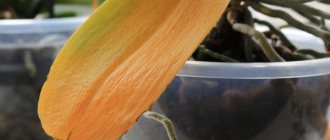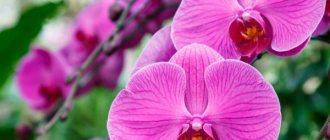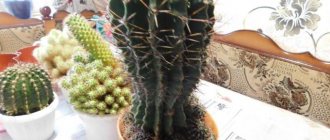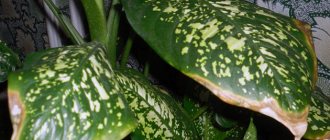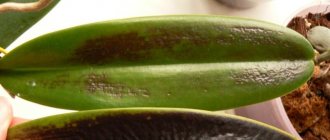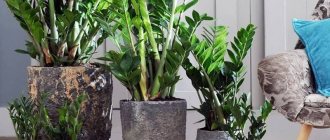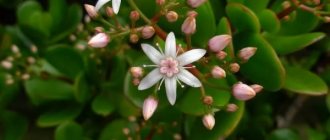Hello, dear readers of my blog! We continue the topic of caring for Zamioculcas - the dollar tree. In general, it is quite unpretentious, but, as usual, problems can arise out of nowhere, and most often they are the result of violation of the rules of care, but many gardeners do not even know about it. If Zamioculcas has droplets on its leaves, then this also indicates the most common mistake, and you will now find out which one.
How to water correctly
Features of the plant
Zamioculcas zamiifolia, also called the dollar tree, contains an unusually high amount of water in its leaves (91%) and tuberous rhizomes (95%).
This ability was developed due to growing in a dry climate. The moisture reserve allows it to survive in low light for four months without water. At the same time, the leaves do not fall until six months - just enough to survive the drought.
Under indoor conditions, such feats are not required from the plant.
Flower growers try to care for and cherish the “green pets” - create a comfortable temperature, water and feed more often. But not everyone takes into account botanical features.
Nature arranges it in such a way that Zamioculcas stores liquid in case of a dry season. However, he still does not come. What should a poor plant do with excess moisture? Removing it through the pores of the leaves is a process called guttation.
If the apartment is dry, for example, during the period of central heating in winter or hot summer, some of the moisture has the opportunity to evaporate.
However, in the off-season, when it is damp both outside and in the apartment, the humidity is increased and droplets of liquid are released instead of evaporation. Therefore, most often the flower cries after watering and before rain. The situation is aggravated by the installation of plastic windows - they disrupt the microcirculation of air between the room and the street.
Tears that appear at the tips of the leaves are a signal to overly responsible gardeners to reduce watering. Moreover, not its intensity, but the intervals between procedures.
Optimal mode
You can’t water it often and a little at a time. On the contrary, the plant must be thoroughly watered until water drips from the bottom hole of the pot. But they do this only 2-3 times a month, and in winter the frequency can be further reduced.
You need to focus on the moisture content of the soil in the flower pot - when it dries to the very bottom, you can carry out the procedure. This can be easily determined with an ordinary pencil or a dry stick.
Chemicals
After treating with a soap solution, you can finish the fight with the help of chemicals. They act more effectively in May-July, when the females are still without protective shields. The best preparations for spraying: Fitoverm, Aktara (KS, VOP).
Processing stages
- After spraying with insecticide, the flower should be covered with a bag and left for 40 minutes.
- Then rinse the seedling in the shower to remove the chemical and dead individuals.
- After 2 weeks, repeat spraying to destroy hidden beetles.
- Check all indoor flowers regularly using a magnifying glass.
Efficiency of Aktara
"Aktara" is a new generation insecticide. It has characteristics such as high efficiency and versatility in use.
This drug is toxic, so all precautions must be taken when using it. It is especially dangerous to inhale the vapors of this product. While working, you must wear gloves, a protective mask and goggles.
If home vegetation is attacked by parasites, then “Aktara” will help cope with them.
"Aktara" is a fast-acting insecticide with enteric contact action. The product is available in granules and suspensions. Its substances have a detrimental effect on many insects.
Advantages of "Aktara":
- It has a high degree of absorption, so the drug is capable of destroying more than 100 types of pests;
- The impact on pests is rapid. After an hour, you can notice the death of the parasites;
- Plants can be treated at any time and in any weather;
- The drug can act for 1 to 2 months;
- Without accumulation effect, therefore does not harm crops.
Disadvantages of Aktara:
- Harmful to bees, wasps, hornets;
- It is not recommended to store in a diluted state.
Dilute the drug only according to the instructions. Treat only trunks, leaves and roots, avoiding flowers and ovaries. After treatment, the flowers should stand for 24 hours, preferably under a bag. Dilute the product only with warm water.
If pests have dug into the root zone, then watering with Aktara will help protect the entire plant. The root system will begin to promote the drug substances throughout all cells of the culture, and the parasites will quickly become saturated with poison.
“Aktara” will destroy their digestive tract, as a result the nerve endings of the parasite will be paralyzed, so the insect will no longer want to suck the juices from the plant. Without food it will soon die.
Other consequences of excessive watering
The secreted juice does not pose a danger to zamioculcas, but it seems to indicate possible problems due to excess moisture.
Why is it important to shed the earthen ball completely, but rarely? — So that the entire root system is involved.
If you water frequently in small doses, the liquid will not reach the lower roots. They will die off as unnecessary, and the upper ones, on the contrary, will begin to rot. As a result, the plant will begin to hurt.
Excess moisture leads to other problems:
- Root rot. It can be easily identified by the leaves and trunk withering and turning yellow at the tips. As a treatment, rotten tubers and roots are removed from the affected specimen. To stop the disease, the cut sites are treated with a disinfectant or sprinkled with ground activated carbon. The old soil must be removed and replanted into new soil. You can purchase ready-made soil for succulents, or prepare it yourself. To do this, sand, leaf and turf soil are mixed in equal proportions. Drainage at the bottom of the pot is required. It is better not to water the flower for the first few days.
- The leaves curl and fall off. Most likely, the root system was attacked by a fungus due to constant waterlogging. The diseased specimen must be dug up, cleaned of the infected soil mixture, and the roots treated with some kind of fungicide. For example, “Maxim”, “Fundazol” or “Benomil”. Replace the soil, make good drainage.
- Holes form on the leaves. There may be several reasons. The first is root rotting due to frequent watering. The second, on the contrary, is associated with a lack of moisture. Third, the soil is depleted and the plant lacks nutrients. To make a diagnosis, zamioculcas must be dug up and the root system checked. If there is rot, it means the flower needs sanitation and replanting. If there are no lesions, then it is most reasonable to replace the soil or replant it in a larger pot and water it more thoroughly, soaking the earthen ball with water to the very bottom.
- Scale insects. These little pests strive to feast on the abundant sap of the plant. They are not difficult to spot, especially when they reach adulthood. They look like upside down shells. But the fight will require patience: large individuals must be removed by hand or with a rag, and the larvae must be destroyed with an insecticide. Actellik is recognized as the optimal drug - it has low toxicity for animals and humans, while being effective. Insecticides are also useful in the fight against other pests: spider mites, aphids and other scourges.
- Anthracnose. The fungus appears as dark spots on greenery. Its cause is a combination of heat and high humidity in the room. For processing, proven means are used: Bordeaux mixture, copper sulfate and colloidal sulfur.
- Powdery mildew, reminiscent of someone scattered flour on the tips of leaves. Treatment of the dollar tree is carried out with the drugs “Skor”, “Topaz” and the like.
Important! Yellowing of leaves is not always a consequence of disease. Their lifespan is limited to six months. Old leaves fall off and new leaves grow. It is quite normal if 5% of the green mass is yellow. But if it’s more than 10%, it’s time to be wary.
Pests
A drop of water can indicate danger
Sometimes the cause of the appearance of water droplets on zamioculcas is not excessive watering, but damage by scale insects, aphids or spider mites. Additional symptoms include miniature brown plaques, as well as changes in the shape of the leaves.
Is it possible to save a flower? Yes, but you need to do it quickly. First, treat the affected areas with mild soapy water; it is especially important to rinse the tips and bases of the leaves. Afterwards you need to spray the above-ground part with insecticides. Among the time-tested pest control agents are Actellik, Bankol and Aktara.
Ideal conditions
the plant releases liquid when the humidity is high
To reduce the likelihood of disease, zamioculcas needs to create acceptable conditions for growth. First of all, the plant loves light, but it must be protected from direct sunlight.
The optimal location is light partial shade. A guest from Africa needs warmth; after all, it is a tropical plant.
The temperature should not fall below 15°C, and the ideal range is 18-26°C. If the humidity is high, it is advisable to ventilate the room.
What to do if the leaves of the plant become sticky? (Shchitovka)
Shields
Diaspididae belong to the family of hemipteran coccid insects with incomplete metamorphosis. All coccid insects, and there are about 3000 species of them, most of them - more than 2600 species of scale insects, the rest are scale insects and felt insects - are herbivorous, feed on plant juices, are voracious and dangerous pests.
All scale insects have pronounced sexual demorphism - males and females differ in structure; very often, when describing a new species of scale insects, scientists characterize only the females, since it is the feeding females that are visible on the stems and leaves of plants, while the males live very little, only before mating, then they die. In some species of scale insects, very few males are hatched - only 2-3%, they are difficult to detect.
What does a scale insect look like?
The eggs of the scale insect are oval in shape; in some species they are elongated oval, usually white or light gray in color, gradually darkening to light brown. The eggs are very small, approximately 0.1-0.3 mm, and look like worms under a microscope.
The first instar larva is called a vagrant
- it has a flattened oval body, up to 0.3 mm long, yellowish in color, three pairs of legs, antennae, eyes. In many species of scale insects, you can tell by the color of the larva what it will regenerate into. So, in the mulberry scale, the strays are white and red, the white ones grow into females, and the red ones into males. The second instar larva is larger. Its body is white or gray, the back of the body is usually darker, its dimensions reach 0.5 mm. At this point, the female larva has no legs, antennae, or eyes. It is distinguished from an adult individual only by its size and lighter coloration of the shield. Among several thousand species, there are scale insects of a slightly different appearance - some have females with an almost transparent body, the shield is invisible, they seem to be glassy; others have very irregularly shaped bodies, like blobs; still others have a rich black shield. The morphological stages of development of scale insects may also differ; for example, some tropical scale insects do not have an egg stage. There is no point in describing a specific type of scale insects; once you see them in photographs or in person, you will no longer confuse them with anyone else.
Scale insect development cycle.
Scale insects have a pronounced life cycle. But there are differences between tropical scale insects and temperate scale insect pests. They are related to climatic conditions. In nature, it looks like this: after mating, the female carries eggs for three months and feeds on plant sap. Three months after fertilization, she lays many eggs, according to various sources, from 250 to 500 eggs, after which she dies.
Scale insects living in temperate climates, such as the apple scale, have the following stages of development: egg >> first instar larvae (vagrants) >> second instar larvae >> males and females >> egg.
Why is Zamioculcas capable of crying?
Zamioculcas zamiifolia is the only representative of the genus of the same name in the araceae family. Although this is a tropical plant accustomed to moisture, drought often occurs in its homeland.
In nature, it grows along the entire southeastern coast of Africa: from Kenya to South Africa. This area is characterized by a clear division of seasons into wet and dry. There are years when not a single drop of rain falls on the ground for 4 or more months.
Zamioculcas learned to survive in these difficult conditions. As a protective reaction, the ability to accumulate large amounts of water in the leaves and thickened rhizomes has been developed. Therefore, when the humidity is high, so that the cells inside the plant do not rupture from excess water, excess liquid is removed through the pores. Drops appear on the leaves, and poetically minded gardeners call them tears.
Signs and superstitions associated with this phenomenon
As a result of long-term observations by flower growers of the dollar tree, a number of signs associated with it appeared. Some say that the flower attracts wealth to the house, others call it women's happiness. The flowering of Zamioculcas brings good luck and prosperity to the owner , and death, on the contrary, brings financial losses.
The crying of a succulent does not bode well for household members. If tears suddenly appear on the green leaves of a plant, this portends bad weather conditions outside the window. Most likely, it will start raining or raining soon. And, by the way, this sign has its own scientific basis.
